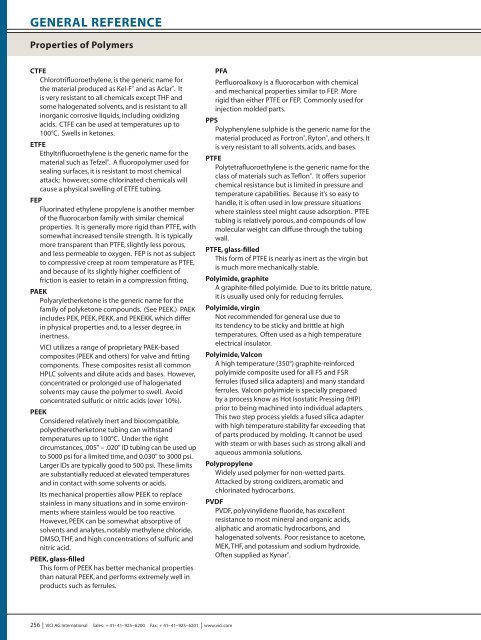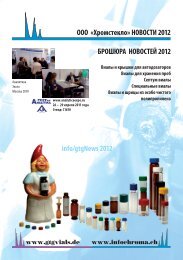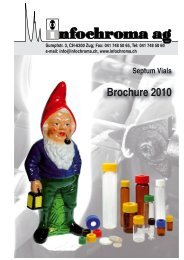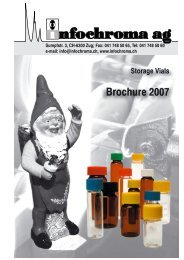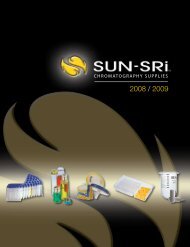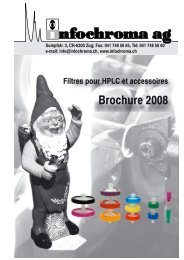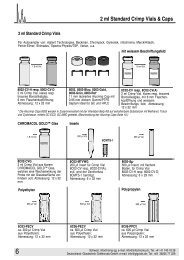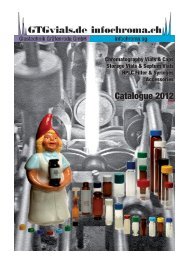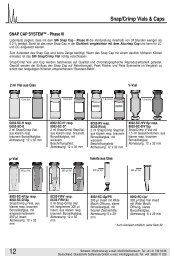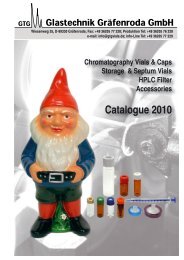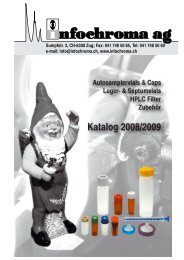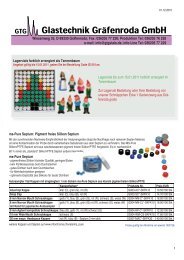Valco Fittings - infochroma ag
Valco Fittings - infochroma ag
Valco Fittings - infochroma ag
Create successful ePaper yourself
Turn your PDF publications into a flip-book with our unique Google optimized e-Paper software.
GENERAL REFERENCE<br />
Properties of Polymers<br />
CTFE<br />
Chlorotrifluoroethylene, is the generic name for<br />
the material produced as Kel-F ® and as Aclar ® . It<br />
is very resistant to all chemicals except THF and<br />
some halogenated solvents, and is resistant to all<br />
inorganic corrosive liquids, including oxidizing<br />
acids. CTFE can be used at temperatures up to<br />
100°C. Swells in ketones.<br />
ETFE<br />
Ethyltrifluoroethylene is the generic name for the<br />
material such as Tefzel ® . A fluoropolymer used for<br />
sealing surfaces, it is resistant to most chemical<br />
attack; however, some chlorinated chemicals will<br />
cause a physical swelling of ETFE tubing.<br />
FEP<br />
Fluorinated ethylene propylene is another member<br />
of the fluorocarbon family with similar chemical<br />
properties. It is generally more rigid than PTFE, with<br />
somewhat increased tensile strength. It is typically<br />
more transparent than PTFE, slightly less porous,<br />
and less permeable to oxygen. FEP is not as subject<br />
to compressive creep at room temperature as PTFE,<br />
and because of its slightly higher coefficient of<br />
friction is easier to retain in a compression fitting.<br />
PAEK<br />
Polyaryletherketone is the generic name for the<br />
family of polyketone compounds. (See PEEK.) PAEK<br />
includes PEK, PEEK, PEKK, and PEKEKK, which differ<br />
in physical properties and, to a lesser degree, in<br />
inertness.<br />
VICI utilizes a range of proprietary PAEK-based<br />
composites (PEEK and others) for valve and fitting<br />
components. These composites resist all common<br />
HPLC solvents and dilute acids and bases. However,<br />
concentrated or prolonged use of halogenated<br />
solvents may cause the polymer to swell. Avoid<br />
concentrated sulfuric or nitric acids (over 10%).<br />
PEEK<br />
Considered relatively inert and biocompatible,<br />
polyetheretherketone tubing can withstand<br />
temperatures up to 100°C. Under the right<br />
circumstances, .005" – .020" ID tubing can be used up<br />
to 5000 psi for a limited time, and 0.030" to 3000 psi.<br />
Larger IDs are typically good to 500 psi. These limits<br />
are substantially reduced at elevated temperatures<br />
and in contact with some solvents or acids.<br />
Its mechanical properties allow PEEK to replace<br />
stainless in many situations and in some environments<br />
where stainless would be too reactive.<br />
However, PEEK can be somewhat absorptive of<br />
solvents and analytes, notably methylene chloride,<br />
DMSO, THF, and high concentrations of sulfuric and<br />
nitric acid.<br />
PEEK, glass-filled<br />
This form of PEEK has better mechanical properties<br />
than natural PEEK, and performs extremely well in<br />
products such as ferrules.<br />
PFA<br />
Perfluoroalkoxy is a fluorocarbon with chemical<br />
and mechanical properties similar to FEP. More<br />
rigid than either PTFE or FEP. Commonly used for<br />
injection molded parts.<br />
PPS<br />
Polyphenylene sulphide is the generic name for the<br />
material produced as Fortron ® , Ryton ® , and others. It<br />
is very resistant to all solvents, acids, and bases.<br />
PTFE<br />
Polytetrafluoroethylene is the generic name for the<br />
class of materials such as Teflon ® . It offers superior<br />
chemical resistance but is limited in pressure and<br />
temperature capabilities. Because it’s so easy to<br />
handle, it is often used in low pressure situations<br />
where stainless steel might cause adsorption. PTFE<br />
tubing is relatively porous, and compounds of low<br />
molecular weight can diffuse through the tubing<br />
wall.<br />
PTFE, glass-filled<br />
This form of PTFE is nearly as inert as the virgin but<br />
is much more mechanically stable.<br />
Polyimide, graphite<br />
A graphite-filled polyimide. Due to its brittle nature,<br />
it is usually used only for reducing ferrules.<br />
Polyimide, virgin<br />
Not recommended for general use due to<br />
its tendency to be sticky and brittle at high<br />
temperatures. Often used as a high temperature<br />
electrical insulator.<br />
Polyimide, <strong>Valco</strong>n<br />
A high temperature (350°) graphite-reinforced<br />
polyimide composite used for all FS and FSR<br />
ferrules (fused silica adapters) and many standard<br />
ferrules. <strong>Valco</strong>n polyimide is specially prepared<br />
by a process know as Hot Isostatic Pressing (HIP)<br />
prior to being machined into individual adapters.<br />
This two step process yields a fused silica adapter<br />
with high temperature stability far exceeding that<br />
of parts produced by molding. It cannot be used<br />
with steam or with bases such as strong alkali and<br />
aqueous ammonia solutions.<br />
Polypropylene<br />
Widely used polymer for non-wetted parts.<br />
Attacked by strong oxidizers, aromatic and<br />
chlorinated hydrocarbons.<br />
PVDF<br />
PVDF, polyvinylidene fluoride, has excellent<br />
resistance to most mineral and organic acids,<br />
aliphatic and aromatic hydrocarbons, and<br />
halogenated solvents. Poor resistance to acetone,<br />
MEK, THF, and potassium and sodium hydroxide.<br />
Often supplied as Kynar ® .<br />
256 | VICI AG International Sales: + 41–41–925–6200 Fax: + 41–41–925–6201 | www.vici.com


